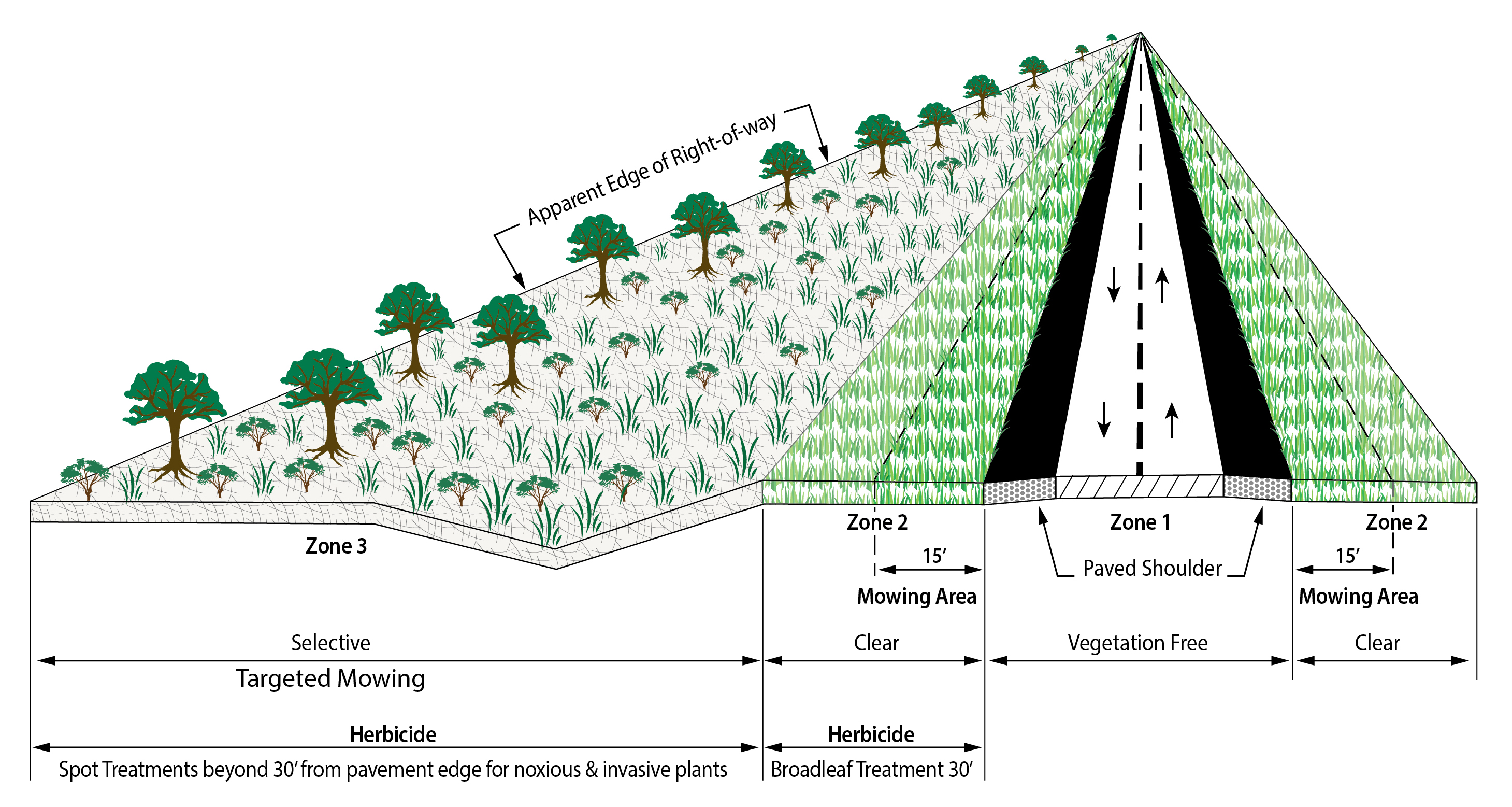INDOT maintains more than 60,000 acres of medians and roadsides along Indiana’s roadways and strives to balance safety, costs, environmental protection, and aesthetics when maintaining roadside vegetation. INDOT’s vegetation management focuses on improving safety along highways by maintaining vegetation at a safe height for driver visibility. Vegetation management practices also preserve natural wildlife habitat and plants, control or remove non-native and noxious plants, and improve the overall look of roadside rights-of-way, promoting greener crossroads.
Mowing Cycles
INDOT performs mowing cycles in order to maximize sight, safety and vegetation management, not for aesthetics or beautification.
By closely monitoring the growth of grass and vegetation, INDOT schedules mowing cycles based on geographic location and weather. Correctly timed mowing cycles positively impact the regrowth of vegetation and can reduce the need for additional mowing.
INDOT has increased the number of mowing cycles in state-maintained roadsides across the state.
- For urban areas, mowing is scheduled five times a year.
- For rural interstates, mowing is completed three times a year.
- For all other routes, mowing is completed two times a year.
Spot mowing may be performed between mowing cycles along any roadway to improve driver visibility and safety.
INDOT Mowing Process
A cool-season grass, like the kind covering most rights-of-way, will put all its energy toward rapid growth and generate seed heads in the late spring/early summer, generally mid-May through early June. Once these grasses establish a seed head, growth slows drastically for the remainder of the year. However, if the seed head is not allowed to develop, the grass will continue to grow rapidly after each mowing, which can render mowing ineffective in a matter of days.
INDOT schedules mowing cycles to maximize the effectiveness of each cycle and minimize the number of cycles needed. Except in areas where mowing is performed to improve driver visibility and safety, the first mowing cycle should ideally occur after seed heads develop — which is approximately mid-May in the southern part of the state and early June in the north. Although this results in tall grass in the late spring/early summer, it requires only two mowing cycles.
The alternative to allowing tall grass to develop would require additional mowing cycles at approximately $300 per right-of-way centerline mile per cycle: a total of approximately $3 million each time INDOT mows every highway roadside.
Vegetation Management
INDOT’s roadside management program includes selective herbicide treatments, prescriptive right-of-way mowing, targeted woody vegetation management, and planting of wildflowers and other native plants.
It costs Indiana taxpayers approximately $15 million each year to mow the more than 40,000 acres of right-of-way along interstates, U.S. highways and state routes maintained by INDOT. Herbicide application costs approximately $32 per treated acre.
Utilization of integrated vegetation management principles reduces the need for mowing and herbicide application, provides multiple benefits to the environment, and saves money. Promoting desirable vegetation and using native plants during revegetation also helps battle invasive and noxious plants.
INDOT employs a three-pronged approach to vegetation management:
- Mechanical
- Prescriptive mowing of herbaceous vegetation
- Zonal approach to mechanical biomass reduction of woody vegetation
- Chemical
- Utilization of selective herbicides on targeted species helps control undesirable vegetation
- Cultural
- By selectively controlling undesirable vegetation, INDOT promotes desirable, healthy stands of vegetation that are more competitive and resilient to disturbance.
- Whenever possible, regionally adapted native vegetation is utilized. Using vegetation that has evolved to grow in our climate also aids in resilience to the impacts of disturbance.
Herbicide Application
INDOT applies selective herbicides to different portions of the right-of-way. Herbicide applications help INDOT combat invasive species and other noxious weeds, as well as keep woody vegetation and other undesirable species at bay for greener crossroads. In addition, herbicide treatments add effectiveness to the mowing cycles by promoting competitive desirable vegetation, enabling a more uniform look between mowing cycles. Herbicide treatments are timed to reduce the impact on adjacent crops and ensure that the development of desirable native vegetation is not negatively affected.
Vegetation Management Zones

INDOT has divided its rights-of-way into different zones for vegetation management. In doing this, the appropriate maintenance can be performed while controlling costs and environmental impact. The primary mowing and vegetation management zones are:
Clear Zone: This area includes highway medians and extends 30 feet out from the edge of the roadway shoulder pavement. This area is mowed at least twice a year and receives an annual selective herbicide treatment to target invasive and noxious plants. In urban areas and other high traffic volume areas, this zone may be mowed three to five times a year, depending on need.
Selective Zone: In areas where right-of-way extends from 30 to 80 feet from the edge of pavement, INDOT enables native plants room to grow to create a natural appearance and provide pollinator habitat. INDOT uses spot mowing and herbicide to control invasive and noxious plants, as well as woody vegetation in these areas.
Natural Zone: Where right-of-way extends more than 80 feet from the road edge, INDOT allows native plants and vegetation to grow and serve as a defense against invasive species. This area shields the roadway from neighboring properties, promotes native plants, and can help connect fragmented wildlife habitat.
Other Zones: Areas adjacent to INDOT bridges and environmentally sensitive areas receive special treatment.
Contact Information
Transportation Services Call Center
Indiana Department of Transportation
100 N. Senate Ave., IGCN 755
Indianapolis, IN 46204
855-463-6848
indot4u.com
